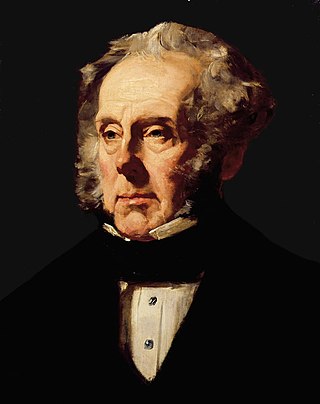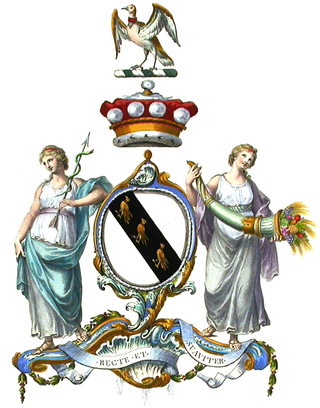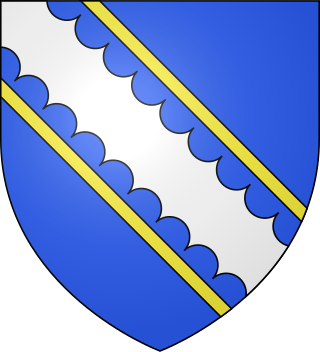
Viscount Palmerston was a title in the Peerage of Ireland. It was created on 12 March 1723 for Henry Temple, who subsequently represented East Grinstead, Bossiney and Weobley in the British House of Commons. He was made Baron Temple, of Mount Temple in the County of Sligo, at the same time, also in the Peerage of Ireland. He was succeeded by his grandson, the 2nd Viscount, who represented seven constituencies in the House of Commons and served as a Lord of the Admiralty and Lord of the Treasury. On his death the titles passed to his son, the 3rd Viscount, who became a distinguished politician and served three times as Foreign Secretary and twice as Prime Minister of the United Kingdom. At his death in 1865 the 3rd Viscount was granted a state funeral, the fourth non-royal to be given this honour. Lord Palmerston was childless and the barony and viscountcy became extinct on his death.

Viscount Cobham is a title in the Peerage of Great Britain that was created in 1718. Owing to its special remainder, the title has passed through several families. Since 1889, it has been held by members of the Lyttelton family.

Marquess of Downshire is a title in the Peerage of Ireland. It was created in 1789 for Wills Hill, 1st Earl of Hillsborough, a former Secretary of State.

Baron Dudley is a title in the Peerage of England. It was created circa 1440 for John Sutton, a soldier who served as Lord Lieutenant of Ireland. The title descended in the Sutton family until the 17th century when Frances Sutton, the heir apparent to the title, married Humble Ward who was granted the title Baron Ward in 1644. Their heirs inherited both titles until 1740 when the differing rules of inheritance meant that the Barony of Dudley descended on Ferdinando Dudley Lea, who became the 11th Baron whilst the Barony of Ward went to John Ward, who later became 1st Viscount Dudley and Ward. On Ferdinando's death in 1757, the title fell into abeyance. The title was revived in 1916.

Earl of Roden is a title in the Peerage of Ireland. It was created in 1771 for Robert Jocelyn, 2nd Viscount Jocelyn. This branch of the Jocelyn family descends from the 1st Viscount, prominent Irish lawyer and politician Robert Jocelyn, the son of Thomas Jocelyn, third son of Sir Robert Jocelyn, 1st Baronet, of Hyde Hall. He notably served as the Lord Chancellor of Ireland from 1739 to 1756. In 1743, he was raised to the Peerage of Ireland as Baron Newport, of Newport, and in 1755 he was further honoured, when he was made Viscount Jocelyn, also in the Peerage of Ireland. He was succeeded by his son, the second Viscount. He represented Old Leighlin in the Irish House of Commons and served as Auditor-General of Ireland. In 1770 he also succeeded his first cousin once removed as fifth Baronet of Hyde Hall. In 1771 he was created Earl of Roden, of High Roding in the County of Tipperary, in the Peerage of Ireland. Lord Roden married Lady Anne Hamilton, daughter of James Hamilton, 1st Earl of Clanbrassil and sister of James Hamilton, 2nd Earl of Clanbrassil, a title which became extinct in 1798.

Earl of Lonsdale is a title that has been created twice in British history, firstly in the Peerage of Great Britain in 1784, and then in the Peerage of the United Kingdom in 1807, both times for members of the Lowther family.

Earl of Dudley, of Dudley Castle in the County of Stafford, is a title that has been created twice in the Peerage of the United Kingdom, both times for members of the Ward family.

Viscount Massereene is a title in the Peerage of Ireland. It was created in 1660, along with the subsidiary title of Baron Loughneagh. From 1665 to 1816 the Skeffington Baronetcy of Fisherwick was attached to the viscountcy and from 1756 to 1816 the Viscounts also held the title of Earl of Massereene. Since 1843 the peerages are united with titles of Viscount Ferrard, of Oriel and Baron Oriel, both in the Peerage of Ireland, and Baron Oriel, in the Peerage of the United Kingdom. The Viscount also holds the subsidiary titles of Baron Loughneagh (1660) and Baron Oriel (1790) in the Peerage of Ireland and Baron Oriel (1821) in the Peerage of the United Kingdom. As Baron Oriel, he sat in the House of Lords until 1999.

Viscount Bridport is a title that has been created twice, once in the Peerage of Great Britain and once in the Peerage of the United Kingdom. The first creation became extinct in 1814, while the second creation is extant.

Viscount Scarsdale, of Scarsdale in Derbyshire, is a title in the Peerage of the United Kingdom. It was created in 1911 for the prominent Conservative politician and former Viceroy of India George Curzon, 1st Baron Curzon of Kedleston, who was created Earl Curzon of Kedleston at the same time and was later made Marquess Curzon of Kedleston.

Earl of Clanricarde is a title that has been created twice in the Peerage of Ireland, first in 1543 and again in 1800. The former creation became extinct in 1916 while the 1800 creation is extant and held by the Marquess of Sligo since 1916.

Viscount Clermont, of Clermont in the County of Louth, was a title in the Peerage of Ireland. It was created in 1776 for William Fortescue, 1st Baron Clermont, with special remainder in default of male issue of his own to his brother James Fortescue and the heirs male of his body.

Viscount Maynard, of Easton Lodge in the County of Essex, was a title in the Peerage of Great Britain. It was created in 1766 for Charles Maynard, 6th Baron Maynard, Lord-Lieutenant of Suffolk. He was made Baron Maynard, of Much Easton in the County of Essex, at the same time, also in the Peerage of Great Britain. Both titles were created with special remainder, failing male issue of his own, to his kinsman Sir William Maynard, 4th Baronet. The 1st Viscount was unmarried and on his death in 1775 the baronetcy of Easton Parva, the Irish barony of Maynard created in 1620 and the English barony of Maynard created in 1628 became extinct. He was succeeded in the barony of 1766 and the viscountcy according to the special remainder by his kinsman Sir Charles Maynard, 5th Baronet, who became the 2nd Viscount. The latter was succeeded by his nephew, the 3rd Viscount, who served as Lord-Lieutenant of Essex. He had no surviving male issue and on his death in 1865 the baronetcy, barony and viscountcy became extinct. His granddaughter, Daisy Maynard, daughter of Colonel Charles Henry Maynard and future wife of Francis Greville, 5th Earl of Warwick, succeeded to most of the Maynard estates.
Baron Bateman, of Shobdon in the County of Hereford, was a title in the Peerage of the United Kingdom. It was created on 30 January 1837 for William Bateman, previously member of Parliament for Northampton. Born William Hanbury, he was the grandson of William Hanbury and Sarah, daughter of William Western and Anne, sister of William Bateman, 1st Viscount Bateman. Lord Bateman was succeeded by his eldest son, the second Baron. He held minor political office and served as Lord-Lieutenant of Herefordshire for many years. The title became extinct on the death of his childless son, the third Baron, in 1931.

William Bateman Bateman-Hanbury, 2nd Baron Bateman, styled The Honourable from 1837 until 1845, was a British peer and Conservative politician.

William Bateman-Hanbury, 1st Baron Bateman of Shobdon was a Member of Parliament and later a Baron in the Peerage of the United Kingdom.

John Bateman, 2nd Viscount Bateman was a British politician who sat in the House of Commons from 1746 to 1784.

William Bateman, 1st Viscount Bateman KB, FRS was an English Whig politician and peer who sat in the British House of Commons from 1721 to 1734, representing the constituency of Leominster.
Baron Docwra of Culmore was a title in the Peerage of Ireland. It was created in 1621 for the leading soldier and statesman Sir Henry Docwra. He was born at Thatcham in Berkshire, saw much military service in Ireland and was successively Governor of Derry, Treasurer of War for Ireland and Joint Keeper of the Great Seal of Ireland.

Shobdon Court was an 18th-century English country house in the village of Shobdon, near Leominster, Herefordshire. Although the main house has since been demolished, the service wing and the stable block have been converted to residential use.












